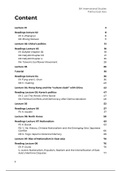Samenvatting
Comprehensive summary for Politics: East Asia
- Instelling
- Universiteit Leiden (UL)
A document containing all lectures, most readings and some tutorial notes . Useful for (online) exams and writing final papers with the in-class discussed material.
[Meer zien]




